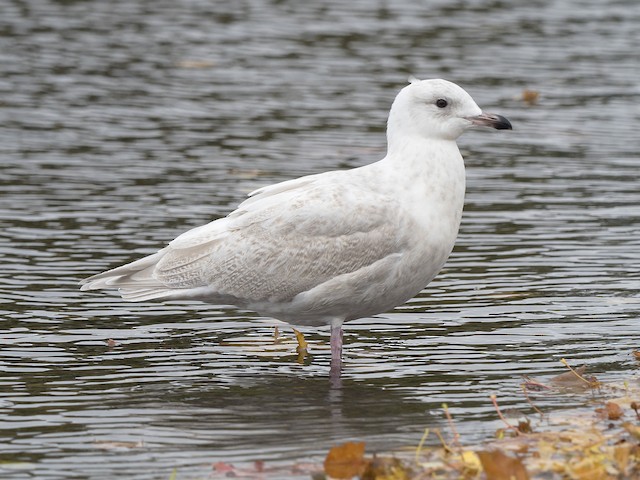Birds are some of the most diverse creatures on the planet. They have achieved this diversity by filling just about every imaginable ecological niche on earth. Just as birds have adapted to fill all the different niches on the planet, there are a plethora of birds that start with the letter I.
Iceland Gull (Larus glaucoides)
The Iceland Gulls are a migratory gull species that winter in the North Atlantic, British Isles, and western Great Lakes across the North American interiors. Contrary to what their name signifies, these birds don’t breed in Iceland but in the Arctic regions of Canada and Greenland.
Iceland Gulls are medium-sized birds that are significantly lighter than other gull species. In comparison to the Herring Gulls, they’re much smaller. They have an overall white body with grey wings.
The call of Iceland Gulls is a high-pitched cry sounding like a laugh.
Imperial Woodpecker (Campephilus imperialis)

The Imperial Woodpeckers are the largest woodpecker species that are endemic to Mexico. These Endangered species feature a wing flap rate much faster in comparison to other woodpecker species.
Imperial Woodpeckers have a black and white upper body with dark brown underparts. The adults are sexually dimorphic to some extent. The males are mostly black and characterize a red-colored crest, with a large, ivory bill and white wing patches.
On the other hand, their female counterparts differ in the crest color, which is immersed in black with hardly a touch of red.
The voice of Imperial Woodpeckers sounds very much like a trumpet.
Ibisbill (Ibidorhyncha struthersii)

Ibisbills are a wader bird species commonly found across the Central Asian Plateau and the Himalayas. They are typically solitary birds, though sometimes spotted in little groups or flocks of eight birds.
Ibisbills are medium-sized and can be identified by their whitish belly, wretched crimson-colored bill, black face, and breast band. Though both the counterparts are almost alike in appearance, the females have a longer bill than their male counterparts.
Indigo Bunting (Passerina cyanea)

Indigo Buntings are tiny migratory songbirds in the cardinal bird family, breeding in North America and wintering in South America. These birds inhabit open woodlands or farmlands and brush areas.
In terms of size, Indigo Buntings closely resemble House Sparrows. Both sexes of the adults are significantly dimorphic. The males have a cerulean blue body and the characteristic indigo head.
In contrast, their female counterparts are mostly brown, with a darker touch on their upper parts. Outside of their breeding season, the males also grow brown edges to their plumage, appearing somewhat like the females.
Indigo Buntings are known to migrate at night occasionally. During this time, they often use the stars to navigate their way.
Ivory Gull (Pagophila eburnea)

Being the monotypic member of their genus, the Ivory Gulls are a tiny Arctic gull species. These seabirds can be found in Greenland, Eurasia, and North America.
The IUCN has listed them as Near-threatened Species and speculates their illegal hunting to be one of the main reasons behind it.
Ivory Gulls are colonial breeders and often gather on the coasts of islands to breed. However, during winters, they spend their time in areas surrounded by sea ice.
These seabirds have black eyes, legs, feet, a thick, grey bill with a yellow tip, and an overall white plumage. Both sexes are identical and develop a red bill tip and red eyes during the breeding season.
Ivory Gulls primarily feed on fishes, rodents, small chicks, and eggs. They are opportunistic scavengers, often following polar bears to feed on the remains of their prey.
Indian Vulture (Gyps indicus)
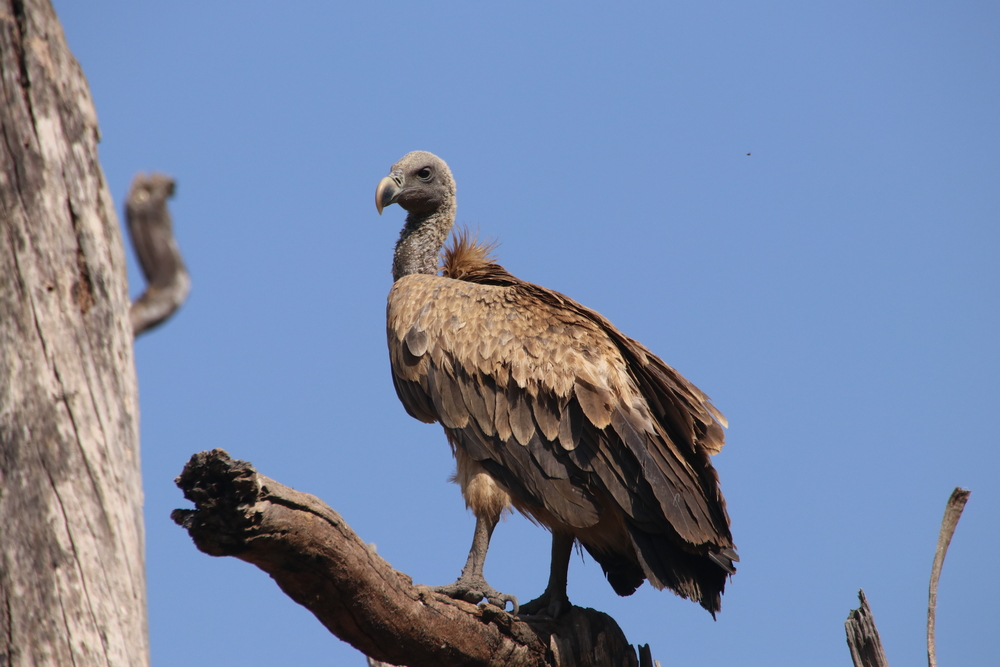
Endemic to India, Pakistan, and Nepal, the Indian Vultures are a critically endangered Old World vulture species.
Indian Vultures have a medium-sized body, pale body, and covert feathers. Their flight feathers are darker, but tail feathers are comparatively short. These scavengers also have a distinguished, long bill with almost bald necks and heads.
Though similar in appearance, the female counterparts are smaller in size than the males. Indian Vultures assemble in flocks and thrive on carcasses mainly collected from human habitation.
Intermediate Egret (Ardea intermedia)
The Intermediate Egrets are a heron species that are also known by several other names, such as “Median Egret,” “Yellow-billed Egret,” and “Smaller Egret.” These wading birds are resident species that inhabit Australia, east Africa, and Southeast Asia.
These medium-sized herons have milk-white plumage, pitch-black legs, and a thick yellow bill with a relatively long wingspan. In the breeding season, their bill turns slightly reddish, their plumage grows yellowish, and they develop light plumes.
The adult Intermediate Egrets are sexually monomorphic. They prefer catching their prey strategically in shallow waters and thrive on frogs, fishes, and insects.
Indigo-capped Hummingbird (Saucerottia cyanifrons)
The Indigo-capped Hummingbirds are a hummingbird species with an extremely restricted range. You can find these hummers only within Colombo. Earlier, they were placed on the Threatened Species list by the IUCN and were taken off it in 2013.
The natural habitats of Indigo-capped Hummingbirds are subtropical or tropical moist lowland or montane forests, shrubby gardens, and decaying forests.
As their name suggests, these hummingbirds have a distinguishing indigo cap resting upon their head, with an olive-green body and a brownish back. There is rarely any visual difference between the sexes.
Ivory-Billed Woodpecker (Campephilus principalis)

The Ivory-billed Woodpeckers are a critically endangered species found in North America.
According to the IUCN, hunting and habitat loss are major threats to their severely declining population. In fact, the American Birding Association has declared that these birds will be “definitely or probably extinct” very soon.
Ivory-Billed Woodpeckers are among the largest woodpecker species globally. They have black plumage with white secondary feathers and white markings on their face. Their plumage has a purplish iridescence all over.
As their name suggests, they have a characteristic ivory-colored bill. The best way to distinguish their sex is by their crest. The males have a red crest, while the females possess a black one.
Island Scrub-jay (Aphelocoma insularis)
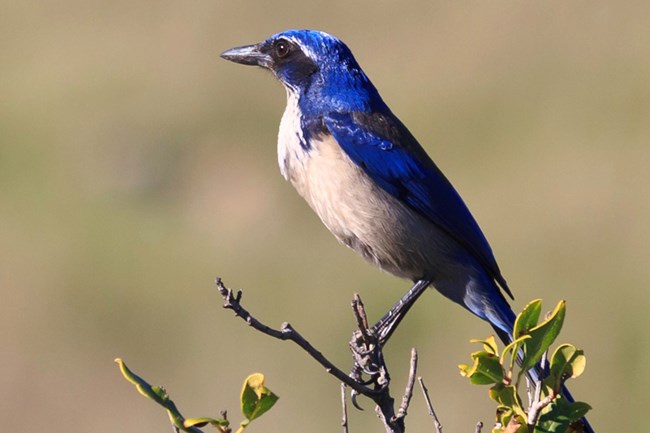
The Island Scrub-jays are a vulnerable species belonging to the corvid family. These little birdies are endemic to North America, where they heavily populate the Santa Cruz Island, which is why they’re also known as “Santa Cruz Jays.”
In appearance, Island Scrub-jays closely resemble the California Scrub-jays, but are larger, have a stout bill, and are more vibrantly colored. They have a blue head and upper parts, with white undersides. On their face, you can also spot a black mask.
Island Scrub-jay’s primary diet includes insects, lizards, and mice. After catching their prey, they often bury it to eat later.
Imitator Goshawk (Accipiter imitator)

The Imitator Goshawks are vulnerable birds of prey species that belong to the Accipiter family.
These raptors are also referred to as “Imitator Sparrowhawk” and are threatened due to habitat loss. They primarily inhabit subtropical and tropical moist lowland or montane forests.
Imitator Goshawks are medium-sized birds with a black back, chest, hood, and throat. Their underparts are white, with a rear edge to their underwings. A sequence of loud piercing whistles characterizes their calls.
Indian Cormorant (Phalacrocorax fuscicollis)
The Indian Cormorants are a fish-eating waterbird species commonly found along the inland waters of the Indian subcontinent, Thailand, and Cambodia.
You can find these birds in the estuaries and mangroves. Like all other cormorant species, they also survival primarily on a fish-based diet.
These cormorants have an average body size among the other cormorant species and a dark, bronze-colored body. They have a black, crestless head and a narrow, hook-tipped bill.
The rest of their body has an iridescent bronze shade. Both sexes have identical plumage.
Inca Dove (Columbina inca)

The Inca Doves are an American dove species belonging to the New World Dove family. They have an abundant population in Costa Rica and have recently been found in Florida within the United States. In some regions, they’re popular as “Mexican Doves.”
Inca Doves have a long and slender body covered in greyish-brown color, with a reddish touch to their breast. Their feathers are scale-patterned, with a long, square tail bordered with white feathers.
Inca Doves produce a fiery, cooing song being perched on a high vantage point. Their song sounds something like “cowl-coo.”
Indian Cuckoo (Cuculus micropterus)
As their name suggests, the Indian Cuckoos are one of the most popular birds found in the Indian subcontinent of Asia. These solitary birds prefer dwelling in open woodlands and forests.
Indian Cuckoos have a medium-sized body with greyish upper parts and deep black barring. Their tail is broad with a white tip.
Although both sexes appear similar, they display some dimorphism; the females have a pale greyish throat, while their male counterparts have a breast colored in a mixed shade of grey and brown.
Indian Cuckoos are primarily insectivorous, mainly feeding on insects and caterpillars. However, you can see them eating fruits, too, particularly during winters.
Invisible Rail (Habroptila wallacii)
The Invisible Rails are a large Indonesian rail species that primarily reside in the sago swamps. The IUCN has listed them as a Vulnerable species, with human activities being a major threat to their population.
Invisible Rails are also referred to as “Drummer Rails.” They have black slate-grey plumage with a long, thick bill and bare skin surrounding their eyes. Their bill and legs are both colored in bright orange. Both the adult sexes are sexually monomorphic.
Icterine Warbler (Hippolais icterina)
The Icterine Warblers are a migratory warbler species belonging to the tree warbler group. These warblers breed in northern and eastern Europe, while in winters, they migrate to Africa.
Icterine Warblers are fairly large for a warbler, featuring a big head, a broad bill, bluish legs, long wings, and a square-shaped tail. Their head and upper parts are greyish green in color, with paler undersides. Both sexes of adults have similar plumage and orange bills.
Icterine Warblers are insectivorous but prefer to take fruits in the late summer.
Indian Eagle-owl (Bubo bengalensis)

The Indian Eagle Owls are endemic to the mountainous and rocky scrub forests of the Indian subcontinent. They’re also known by several names, including “Rock Eagle-owl” and “Bengal Eagle-owl.”
Unlike most solitary owls, these owls prefer the company of their own and are usually spotted in pairs. They have a similar appearance to the Eurasian Eagle-owls and were even considered their subspecies earlier.
The facial disk of Indian Eagle-owls is black-tipped. Their folded wings are characterized by large, pale brown patches. The rest of their body is wrapped in brownish-grey, with black stripes running along their white throat. Adult Indian Eagle-owls are sexually monomorphic.
Just like the other owls, Indian Eagle-owls are also carnivores and feed mainly on rodents. These vicious hunters tear their prey apart instead of simply swallowing them.
Imperial Amazon (Amazona imperialis)

Imperial Amazons are declared the national bird of Dominica, due to which they’re also referred to as “Dominican Amazon.” These large parrots are considered a Critically Endangered Species by the IUCN.
Imperial Amazons are endemic to the Caribbean, where they primarily inhabit the mountain forests. In some regions, they’re also known as “Sisserou.”
These parrots have a typically muscular tongue and a hooked bill. Their hinged mandible and tongue help them move food inside their mouth easily.
The identical plumage of both the sexes features dark purple crests, dark green upperparts, and black feather tips. Their eyes are colored in a combination of red and orange.
Inca Tern (Larosterna inca)

The Inca Terns are the monotypic member of the Larosterna genus. These terns are near-threatened species and are migratory.
Inca Terns are known to breed in the coastal regions of South America (Chile and Peru). During winters, they don’t migrate routinely but are occasionally seen in Ecuador.
They are large birds with their body being covered in slate-grey. Only their legs and bills are vibrant red. You can also notice white and yellow marks behind their eyes.
The main diet of Inca Terns consists of small fish, particularly anchovies.
Island Imperial Pigeon (Ducula pistrinaria)
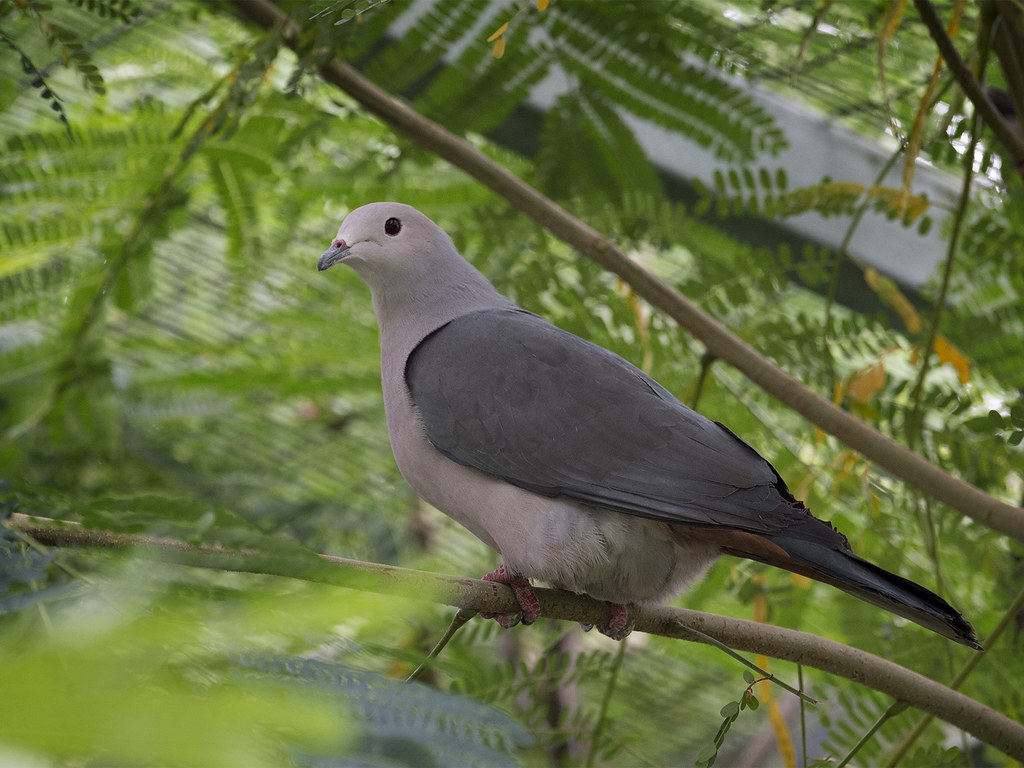 `
`
As their name suggests, the Island Imperial Pigeons are a pigeon species found on the Solomon Islands and the Bismarck Archipelago. These birds primarily inhabit mangroves, primary and secondary forests.
Island Imperial Pigeons are medium-sized birds that display glossy upperparts, a light grey neck and head, and greyish green wing coverts. Their slaty blue beak has a bold black tip.
The upper portions of their tail are dark blue-green, but the lower portion is colored in chestnut.
Island Imperial Pigeons are colonial birds commonly spotted in small flocks. They’re mainly frugivores and feed on fruits from canopies.
Italian Sparrow (Passer italiae)

Also referred to as the “Cisalpine Sparrow,” the Italian Sparrows are passerine birds found in Italy and parts of the Mediterranean region. The IUCN has listed them as Vulnerable Species.
Italian Sparrows display dimorphism both in size and in plumage. The males have chestnut upper parts and heads with pale grey underparts. They also have white cheeks. The black patch on their throat and chest is termed “bib” or “badge.”
On the other hand, their female counterparts resemble the House Sparrows and have no black streaky underparts. They’re also smaller in size than the males.
Inland Dotterel (Peltohyas australis)

The Inland Dotterels are an Australian shorebird species. These birds inhabit saltbush and blue bush and are also known as “Prairie Plover,” “Inland Plover,” and “Australian Plover.”
Inland Dotterels have a medium-sized body with a short bill and unique cryptic plumage. Their upper parts are rich, polished buff in dark brown.
Both the adult sexes have a similar size.
Inland Dotterels are insectivorous shorebirds, with spiders, ants, and beetles constituting their main diet.
These birds have the special feature of tolerating high temperatures. Although if the temperatures touch extreme levels, they tend to look for a sheltered area.
Ivory-billed Woodcreeper (Xiphorhynchus flavigaster)
Found in Central America, the Ivory-billed Woodcreepers are members of the ovenbird family. These birds inhabit moist lowland and dry forests in tropical and subtropical areas.
Just as their name suggests, the Ivory-billed Woodcreepers have a pale, ivory-colored bill. They have a reddish-brown plumage, with whitish streaks on the head. Their stiff features help in climbing trees.
Ivory-billed Woodcreepers eat mostly insects from barks or by following marching ants. Their voice has a distinctive shrill tone which can easily be differentiated in the forests.
Indian Skimmer (Rynchops albicollis)
Also referred to as “Indian Scissor-bill,” the Indian Skimmers are tern-like seabird species found in the Indian subcontinent.
Due to habitat loss and pollution, they’re placed on the Endangered Species List by the IUCN. Because these birds tend to nest on coastal wetlands, they’re highly prone to get trampled.
Indian Skimmers are medium-sized birds with an overall white plumage and a bright orange-yellow bill. They have a black cap and darker underwings and tails. While both sexes look identical, their plumage undergoes several changes according to the season.
Indonesian Honeyeater (Lichmera limbata)
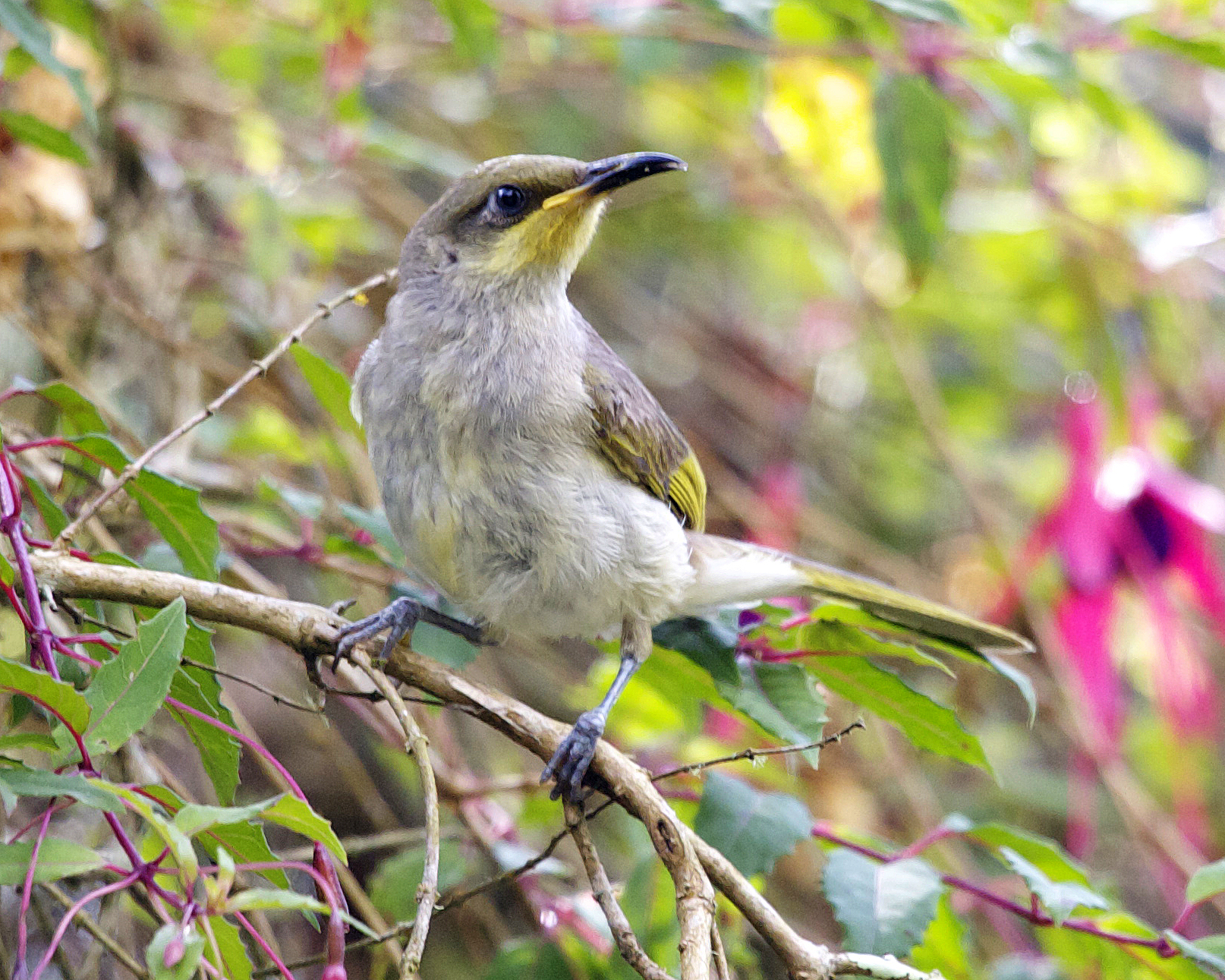
As their name suggests, the Indonesian Honeyeaters are a honeyeater species found in Indonesia and Southeast Asia. These birds thrive in tropical lowland and mangrove forests.
Indonesian Honeyeaters are often compared to Australian honeyeaters because of the similarities in their appearances. They are generally small, tender birds with overall greyish wings and black bills. Little is known about the dimorphism displayed between the sexes.
Indonesian Honeyeaters have diverse vocals, consisting of chirps, whistles, and rattles, and can be quite noisy in large flocks.
Iris Lorikeet (Saudareos iris)

The Iris Lorikeets are a tiny, arboreal parrot species found in Southeast Asia and Indonesia. The IUCN has placed these birds into the Near-threatened Species List, mainly because of their excessive illegal trapping.
Iris Lorikeets have a red forehead, orange beak, and a dark eye patch. Compared to other lorikeets in their family, they have a softer high-pitched shriek. Another factor that distinguishes them from other lorikeets is their strongly built beak.
The only difference between male and female Iris Lorikeets is that females have a lesser pale head than their male counterparts.
Conclusion: Birds That Start With I
Wow, what a ride! Birds are some of the most amazing creatures on Earth. I hope you enjoyed our journey through the birds that start with the letter I.
And I’d like to ask you to please SHARE this article via your preferred social media channels (Twitter, Facebook, etc.) – it will help support our site and let us know that you care :).
Birds By Alphabet (A-Z List)
Birds that Start with A
Birds that Start with B
Birds that Start with C
Birds that Start with D
Birds that Start with E
Birds that Start with F
Birds that Start with G
Birds that Start with H
Birds that Start with I
Birds that Start with J
Birds that Start with K
Birds that Start with L
Birds that Start with M
Birds that Start with N
Birds that Start with O
Birds that Start with P
Birds that Start with Q
Birds that Start with R
Birds that Start with S
Birds that Start with T
Birds that Start with U
Birds that Start with V
Birds that Start with W
Birds that Start with X
Birds that Start with Y
Birds that Start with Z


